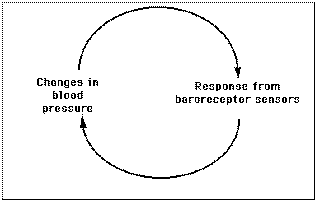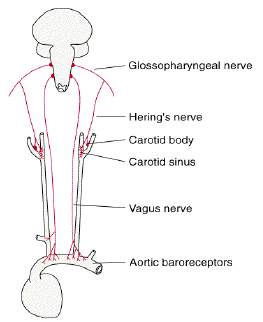Case Studies and Project Ideas: Baroreceptor Dynamics

Medicine and the Biosciences Main Page
Other Case Studies and Project Ideas
Investigating Interaction between the Cardiovascular and Neurological Systems
Source:
Dr. Jeffery Kiel, University of Texas Medical Center. Used by permission. Case study narrative by Robert. R. Gotwals, Jr.
Overview:
The goal of this simulation is to simulate the ventricular pressure-volume relationships for the left and right heart, specifically, the influence of baroreceptors and the autonomic nervous system (ANS) on blood pressure in the arterial system. By changing several key variables (particularly the chronotropic and inotropic influence of the autonomic nervous system), this simulation can demonstrate changes in arterial system pressure over a simulated period of time.
Baroreceptors are sensors found in the major arteries of the body, including the carotoid arteries and the aorta. When the arterial pressure is increased, the sensors are stretched, signals are transmitted into the central nervous system. Feedback signals are sent back to reduce arterial pressure downward toward the normal level. This is a process of negative feedback. This nervous control of the arterial pressure is by far the most rapid of all our mechanisms for pressure control.

A schematic is useful in understanding baroreceptors in arterial pressure control.

Building the Model:
Some suggestions for building this model:
General:
Look at the model as three parts:
a blood volume/cardiovascular section, a neurological section, and a “timer” or cardiovascular engine section. Build each section one at a time. We’ll start with the timer section, move to the blood volume section, and finish with the neurological section.
Description of the Blood Volume/Cardiovascular Section:
Description of the Blood Volume/Cardiovascular Section:
Description of the Neurological Section:
Other Values needed to run this model:
You should run this model for 50 minutes at a DT of 0.01. Euler’s method is suitable for this model, and will allow your model to run in a reasonsable period of time.
Developed by
 The Shodor
Education Foundation, Inc.
The Shodor
Education Foundation, Inc.
Copyright © 2000-2003
Questions or comments about this page should be directed to biomed@shodor.org




 The Shodor
Education Foundation, Inc.
The Shodor
Education Foundation, Inc.